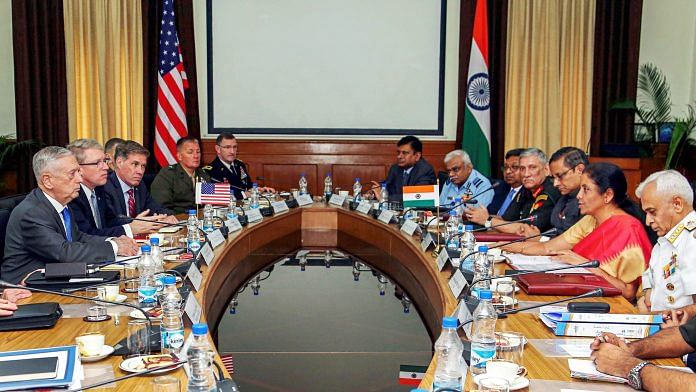The signing of COMCASA effectively nudges India towards an ‘Asian Nato’ in a quadrilateral grouping along with Japan and Australia.
New Delhi: India and US Thursday approved the landmark Communications Compatibility and Security Agreement (COMCASA), a military communications secrecy pact in the works for a decade-and-a-half, during the historic “2+2” meeting.
The breakthrough was made this afternoon at the meeting between the Indian foreign and defence ministers Sushma Swaraj and Nirmala Sitharaman and the US foreign and defence secretaries Mike Pompeo and James Mattis.
The agreement effectively nudges India towards an ‘Asian Nato’, along with Japan and Australia, in a quadrilateral grouping or ‘quad’. This annoys China the most.
“Comcasa is India-specific. It doesn’t commit us to buying US systems,” an Indian official source said. “The text is confidential. Valid for 10 years. We have ensured we have full access to systems without any disruptions. It is platform-specific. It is an enabling instrument. It will enable us to derive optimal use of US platforms.”
Originally known as the Communications Interoperability and Security Memorandum of Agreement (CISMOA), the US changed the nomenclature to COMCASA to make it India-specific. This was similar to its move with the Logistics Exchange Memorandum of Agreement (LEMOA), signed in August 2016, that was originally known as the Logistics Support Agreement (LSA).
China had questioned India intensely after the LEMOA was signed.
‘Foundational agreements’
The US describes these documents as “foundational agreements” along with the Basic Exchange and Cooperation Agreement for Geo-Spatial Cooperation (BECA). US law requires the signing of these agreements for the US to enter into military alliances that would permit it to export sensitive equipment.
An earlier and rudimentary variant of the COMCASA was signed in 2002. It was called the General Security of Military Information Agreement (GSOMIA). But GSOMIA did not cover many sensitive technologies that the COMCASA may now pave the way for.
Also read: India and US are holding their first 2+2 dialogue. Here’s all you need to know
The US usually has these agreements with its NATO partners. In Asia, Pakistan had similar arrangements with the US for 10 years after then US president George Bush described it as a “major non-NATO partner” in 2003.
The US also has similar arrangements with Japan, South Korea and Australia among the major powers in the “Indo-Pacific” region.
As India had not signed the agreement earlier, the Indian Air Force bought US platforms without US proprietary communications equipment. Among these were the C-130 Hercules special operations planes and the Globemaster C-17 strategic airlifters.
The Hercules, for example, is meant to insert commandos in hostile territory, and has the ability to land and take-off quickly. For such operations it has to be in communication with the commandos. Such secure and encrypted communication from the US has not been shared with the IAF for planes. India instead uses its own systems.
The IAF has also now contracted 15 heavy-lift Chinook helicopters and 22 Apache attack helicopters that are scheduled to be delivered from next year. The US has said that these helicopters would also be delivered minus the sensitive proprietary communications technology.
But, depending on the contours of the COMCASA, the details of which are yet to be disclosed, India may be able to re-negotiate the terms of those contracts or order the coded systems separately.
Concerns
However, even as India goes ahead with the COMCASA, there are deep concerns in the military on whether it runs heavy risks.
Foremost among these is the fear of data leak to adversaries. For example, the US has supplied the F-16 Fighting Falcon to the Pakistan Air Force. Although US firm Lockheed Martin asserts that it has adequate firewalls to prevent the leak of information, the worries remain.
Without a doubt, the COMCASA in its original form, the CISMOA, was easily an intrusive instrument. But so was the End User Verification Agreement that India and the US approved about 10 years back. Both require US officials to enter, install and inspect US proprietary equipment in Indian military stations and on board Indian military platforms.
This was the primary reason that the Left in India and, at one time, the Bharatiya Janata Party (BJP) itself was against these agreements. It was stalled by the United Progressive Alliance (UPA) government when an adamant defence minister A.K. Antony refused to have anything to do with them.
Also read: 2+2 dialogue a ‘major opportunity’ to work on diplomatic, security issues with India: US
But the Indian Navy and the US Navy, that have one of the most robust and intensive wargames on a regular basis, are far more comfortable with the agreement. Indeed, in almost all the bilateral or multilateral naval exercises, Indian ships, carriers and submarines have accepted the US’ CENTRIXS (Comprehensive Enterprise for Regional Information Exchange System) platform. These “talk boxes” are installed for the duration of the wargames.
NATO operates on the system when it works in coalition operations.






